Contents
RF Spectrum
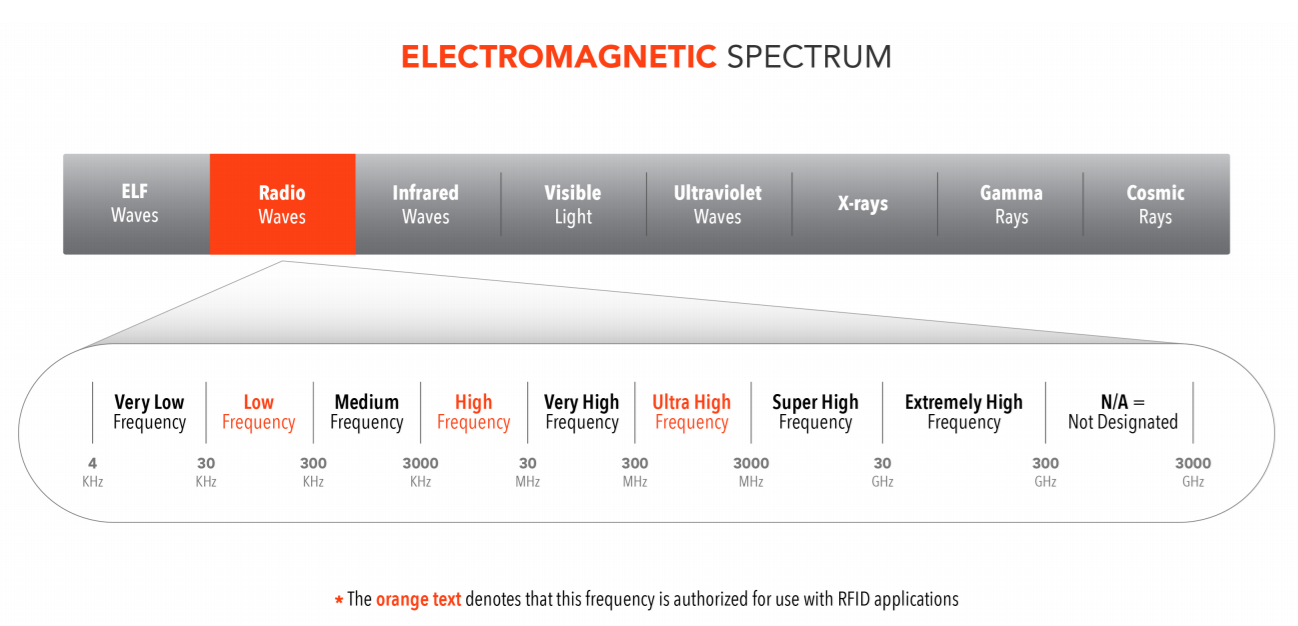
Radio Waves
The electromagnetic spectrum is composed of various frequencies of waves that are produced using electromagnetic energy. A radio wave is essentially a disturbance through space that carries energy from one place to another. Radio waves oscillate, in that, while traveling the energy continuously rises and falls in intensity. This oscillation is what is typically depicted as a wave pattern consisting of peaks (highs) and troughs (lows). The path from trough to trough, or peak to peak, is considered a full wave cycle, and the number of cycles that take place in one second is known as the wave’s rate of oscillation.
Radio waves are characterized by frequency and wavelength. Frequency is measured in Hertz, and one Hertz is equal to one full wave cycle per second; so, frequency is dependent upon the wave’s oscillation rate.
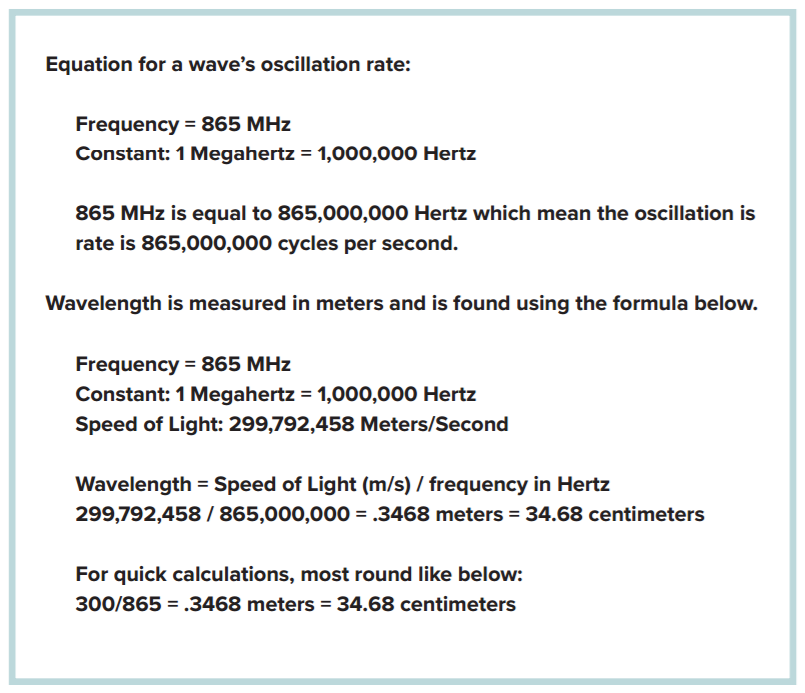
Wavelength
Within the radio wave subset of the RF spectrum, there are eight designated frequency bands:
- Very low frequency
- Low frequency
- Medium frequency
- High frequency
- Very high frequency
- Ultra-high frequency
- Super high frequency
- Extremely high frequency
Starting at the left side of the spectrum and moving right, the wavelength gradually decreases. Very low frequency (VLF), the first frequency range on the left side of the spectrum, has an average wavelength of around 55,000 meters. That means that a VLF wave, from one peak to another (or one trough to another), has an average distance of 55,000 meters, or around 500 U.S. football fields stacked together. Because radio wavelengths correlate with the speed of data transmission (i.e. the longer the wavelength, the slower the data transmission and vice-versa), VLF waves result in very low read rates; therefore, VLF is not used commonly for RFID applications.
Of the eight frequencies on the radio wave band, there are three that are typically used for RFID applications:
- Low frequency (LF)
- High frequency (HF)
- Ultra-high frequency (UHF)
Low Frequency
About
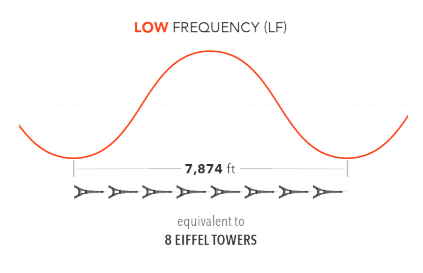 The Low Frequency, or LF band, is between 30 kHz and 300 kHz with long wavelengths of around 2,400 meters. Because there are multiple types of signals communicating on this band, LF RFID systems are only allowed to use the small range between 125 – 134 kHz. The large wave size allows LF waves to penetrate metal and water which is unique to this frequency band.
The Low Frequency, or LF band, is between 30 kHz and 300 kHz with long wavelengths of around 2,400 meters. Because there are multiple types of signals communicating on this band, LF RFID systems are only allowed to use the small range between 125 – 134 kHz. The large wave size allows LF waves to penetrate metal and water which is unique to this frequency band.
Although LF RFID has a long wavelength, the read range is shorter than both HF and UHF RFID – only extending from a couple centimeters, up to about 50 centimeters in ideal conditions. The short read range is due to dependence on magnetic coupling.
LF tags are generally more expensive than HF and UHF RFID tags, but vary in cost depending on the type and the application. Usually, they cost anywhere from $0.70 - $20.00 per tag, and are powered solely via magnetic coupling – meaning they could last indefinitely depending on the wear and tear of the application. They come in a variety of shapes and sizes, but all tags use the same type of magnetic coupling for power and communication. These tags also have relatively slow read rates because the data rate of transmission is very low and it takes longer for the reader to receive and decode the tag’s signal.
LF antenna/RFID reader combinations are available depending on the application, and generally cost anywhere from a couple hundred dollars up to a thousand dollars (USD). Unlike other RFID tags, LF tags do not have security standards, so they are not recommended for applications where encrypted communication is a requirement.
Applications
LF RFID systems are used most often for animal tracking applications (e.g. pet tagging and livestock identification), but are also used in some access control applications. LF tags are ideal for animal tracking applications because they are easily read through the animal’s body (containing water).

High Frequency
About
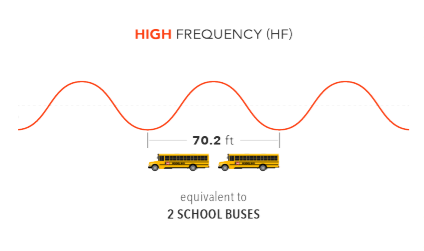 The high frequency (HF) band on the RF spectrum extends from 3 MHz to 30 MHz. The wavelength of a high frequency wave is much shorter than an LF wave – only around 22 meters, or a little less than 2 school buses in length. High frequency, like low frequency, uses magnetic coupling to communicate between the tags and the RFID reader/antenna. HF waves can pass through most materials except for water and dense metals. Thin metals, like aluminum, can still be tagged with HF tags and function normally.
The high frequency (HF) band on the RF spectrum extends from 3 MHz to 30 MHz. The wavelength of a high frequency wave is much shorter than an LF wave – only around 22 meters, or a little less than 2 school buses in length. High frequency, like low frequency, uses magnetic coupling to communicate between the tags and the RFID reader/antenna. HF waves can pass through most materials except for water and dense metals. Thin metals, like aluminum, can still be tagged with HF tags and function normally.
HF RFID tags usually have a general read range of a few centimeters up to about a meter in length depending on the setup of the system.
Within the high frequency band of the RF spectrum, near-field communication, or NFC, is a communication protocol approved by the International Organization of Standardization, or ISO (ISO 14443 & ISO 18000-3). Because NFC is a global communication standard, and therefore regulated, it operates on a single frequency - 13.56 MHz. Being approved as a global communication standard and operating only on one frequency makes NFC easily adaptable for hundreds of applications.
HF and NFC tags are relatively inexpensive but can range in cost depending on the size and form factor from about $0.35 - $10.00 per tag. The tags are usually delivered as labels, cards, or plastic encased tags and are generally small in size so that they can be applied to many different types of items. HF tags rely on magnetic coupling as their power source so they tend to last the lifespan of the application unless damaged by wear and tear to the tag.
HF RFID readers are used with HF tags and are relatively low in cost, generally not more than a few hundred USD. NFC tags can be read with the same HF readers, including any smartphones that contain HF/NFC readers. The ability to be read by smartphones give HF/ NFC tags the ability to gain widespread popularity in countless applications.
Applications
HF and NFC RFID applications are continuously emerging from numerous companies looking to solve business problems using RFID technology. NFC is particularly popular in marketing applications like advertising posters, smart items, and brand/item interactive experiences. The most used applications for HF RFID are access control applications, data transfer applications, and some ticketing applications.
HF RFID tags are also used in passports across the world in countries like the United States, Norway, Japan, Australia, India, and more. There has been criticism in the past about the security of these tags in passports which was later addressed by adding both a metal lining to lower the read range, and a password that has to be keyed into the RFID reader to read the tag.
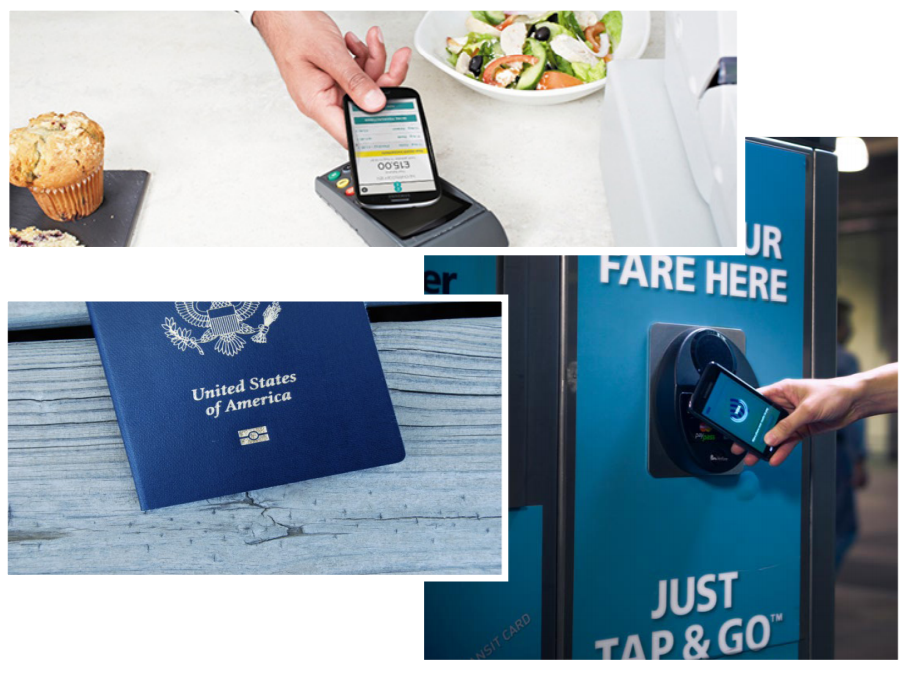
Ultra-High Frequency
About
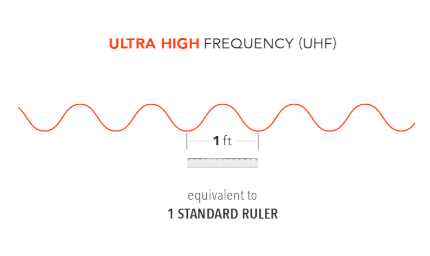 The ultra-high frequency (UHF) band within the RF spectrum ranges from 300 MHz to 3 GHz; however, most UHF RFID systems operate between the 860 – 960 MHz bands. The primary exceptions are RFID systems that operate at 433 MHz and 2.45 GHz.
The ultra-high frequency (UHF) band within the RF spectrum ranges from 300 MHz to 3 GHz; however, most UHF RFID systems operate between the 860 – 960 MHz bands. The primary exceptions are RFID systems that operate at 433 MHz and 2.45 GHz.
UHF RFID systems function within these designated bands due to communication protocol standards put in place by GS1 as well as frequency regulatory standards set by individual countries/regions. These standards and regulations are an integral part of RFID. If they didn’t exist:
- Devices could interfere with each other and would be either inoperable or have very poor efficiency as they compete for bandwidth.
- Widespread adoption of the technology would be challenging because systems would be operating in disparate bands and have differing protocol/signaling standards.
UHF RFID systems do not communicate through magnetic coupling; rather, they use passive backscatter modulation according to GS1 EPCglobal UHF Class 1 Gen 2 specifications (which are ratified as an ISO-18000-6C standard).
UHF waves are, on average, around 33 centimeters (or one foot) in length; but, in the higher frequencies, like 2.45 GHz, they can be as small as 12 centimeters in length. UHF RFID is typically deployed in one of two types of RFID systems – passive or active.
Passive UHF RFID
The defining quality of passive UHF RFID systems (when compared to active UHF RFID systems) is the way in which the RFID tags function. Passive UHF RFID tags rely on passive backscatter modulation to function and have no additional power source. In short, this means that the RFID reader sends its energy through the antenna as RF waves to the UHF RFID tags in order for them to become energized and respond back to the reader. The response is called backscatter because the tag scatters back a portion of the energy that it receives from the reader. Because there is no additional power available to the tag other than what is provided by the reader, these systems have a maximum read range of around 30 meters.
UHF RFID passive tags have some of the lowest costs due to widespread adoption. Volume quantities of UHF RFID tags can dip as low as $0.10 cents a tag while maintaining an average read range of 2-5 meters. UHF RFID passive tags have decreased in cost substantially over the years allowing companies and individuals to use low-cost, label tags as disposable asset identifiers.
Passive UHF tags are very sensitive to both liquids and metal. This is because the UHF waves reflect off, refract within, or absorb into non-RF-friendly materials. Though performance degradation in the presence of liquids and metals may be difficult to overcome, interference can be mitigated by analyzing the application environment and employing techniques to overcome obstacles, such as installing RF shielding and/or using metal-mount RFID tags.
Passive UHF tags come in many form factors and are usually subdivided into categories like rugged, high-temperature, label tags, high memory, etc. The tags tend to last the lifespan of the application unless damaged by wear and tear, and because they do not have batteries, their lifespan is not dependent on a power source.
The hardware for UHF RFID system requires a more significant investment than HF and LF system equipment. Readers range between $450 for a low-cost reader up to over $2,500 for a rugged handheld RFID reader.
Passive UHF RFID Applications
Passive UHF RFID systems are used in hundreds of different applications such as tool tracking , IT asset tracking, race timing, and laundry management. New applications for these tags are being discovered frequently due primarily to the tags’ long read range and low cost. Read more about UHF passive applications.
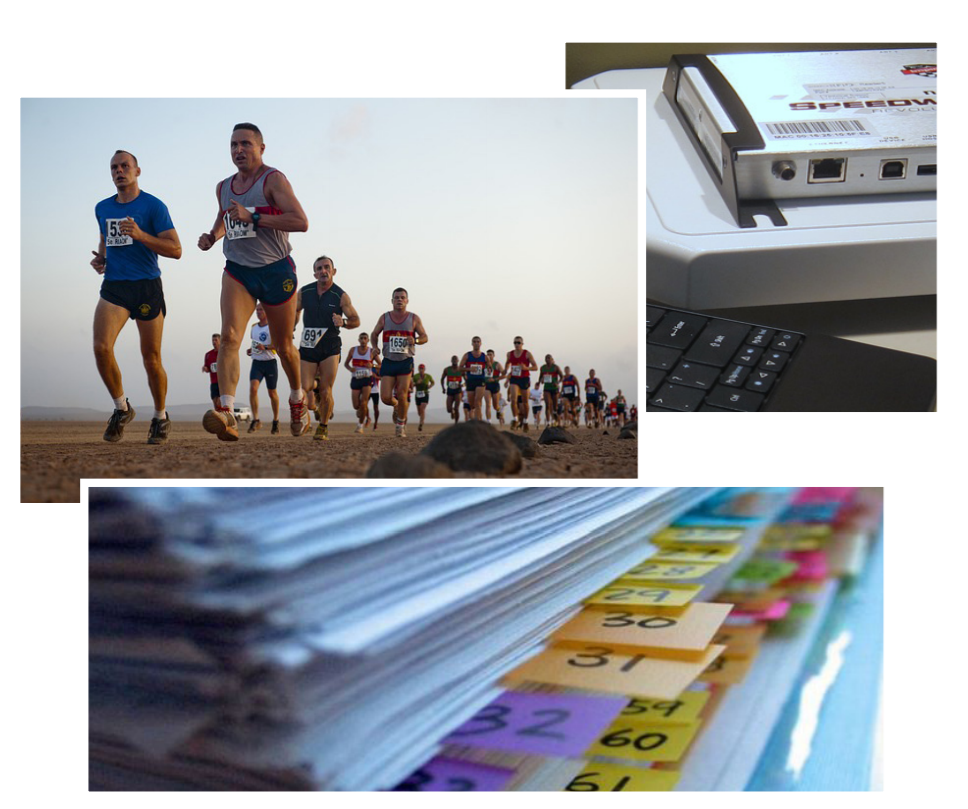
Active UHF RFID
Active UHF RFID systems do not rely on passive backscatter to function; instead, they use an internal battery as a power source. Because these tags contain a battery, they do not need to be energized by an RFID reader; instead, they proactively beacon at predetermined intervals. These beacons announce the presence of the tag to any readers that are within range of the tag. Active RFID readers detect the beacons from the tags and pass them on to a host system for processing.
Active UHF RFID tags can have a very long read range due to the internal battery, with beacons that can be detected by readers over 100 meters away. The signal boosting power received from the internal battery also helps these tags to overcome any materials that usually hinder RF waves like metal and water. Certain active RFID tags are engineered to withstand harsh environments like extremely low temperatures and rugged applications, including being able to continue beaconing while being buried in snow or dirt.
Active RFID tags are relatively expensive because they contain an internal battery and other electronics components. Depending on their features (e.g. Wi-Fi, Bluetooth, GPS), these tags cost $20 per tag and up. One drawback of active tags is their limited lifespan. Because they rely on a battery for power, these tags (like their batteries) can only last about 3-5 years (depending on beacon rate). While that timeframe works well for some applications, other applications may require the tags to be replaced.
Active UHF RFID Applications
Active UHF RFID applications are frequently used in industries like oil and gas, transportation, and vehicle tracking. Because active tags beacon, they are easier to read while moving and are ideal for tracking cargo containers and vehicles. Additionally, tracking items like pipes and construction equipment is one of the more popular uses for active RFID because laydown yards encompass very large areas. Active tags can be installed on materials and large assets outdoors and read by handheld or vehicle mounted readers in order to obtain their location information.

How to Choose
In order to choose the type of RFID that works best for a given system, certain requirements need to be considered such as read range, data transmission rates, available features, etc. A convenient way to analyze the frequency, tag, and hardware options is to answer questions about the application. For example:
- What is your application?
- Are there any extreme environmental factors to consider?
- What type of read range is required?
- What type of material comprises the items being tagged?
- Do you have any tag size restrictions?
To learn more about choosing RFID hardware and deploying it, read our RFID Buyer’s Guide and Deploying RFID: 20 Questions & Answers. If you have any questions, don’t hesitate to contact us.

